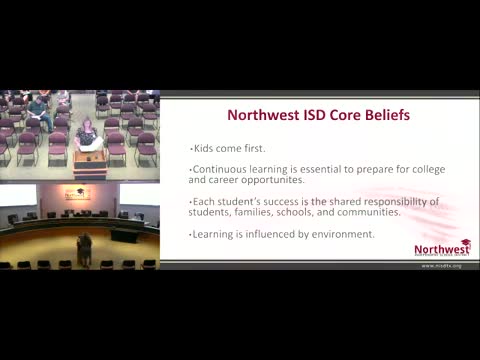District officials report expansion of tutoring, intervention and special‑education services after pandemic year
January 02, 2025 | NORTHWEST ISD, School Districts, Texas
This article was created by AI summarizing key points discussed. AI makes mistakes, so for full details and context, please refer to the video of the full meeting. Please report any errors so we can fix them. Report an error »

District student‑services and special‑education staff told the board on June 14 that they increased staffing and remote supports during the pandemic and reported student progress in targeted interventions.
Dr. Eddie (student services) said the district added 11 compensatory‑education elementary interventionists and other staff to support at‑risk learners and that elementary reading programs and summer offerings have grown. He highlighted the district’s Parents as Teachers program, which served 168 families (282 children) this year and produced an average “13 months kindergarten concept growth in the 9 months of services,” staff reported.
Dr. Eddie and his team also described testing and intervention tools adopted this year. Districts used MAP Growth and MAP Skills to target classroom and small‑group instruction and reported positive early feedback from campuses that used the tools. Staff said MAP allowed more tailored interventions than single‑day assessments, and that several campuses plan to expand MAP Skills use.
Special education: expanded units and early screening
Special‑education staff reported growth across programs and special‑needs units, including plans to relocate the RISE/Horizons transition program to the Legacy Learning Center next year and to open a full‑day four‑year‑old early‑childhood classroom at Justin.
“We have completed 420 screenings this year; 190 were referred for testing and 150 qualified for services,” the special‑education director said, noting the district completed more than 2,000 evaluations this year (some deferred from pandemic closures). Staff said 134 students were dismissed from services after meeting goals and that 96% of students receiving special‑education services who graduated met college‑, career‑ or military‑readiness standards.
Program outcomes and next steps
Reading‑recovery and literacy interventions showed measurable gains: of 62 reading recovery students, staff reported 58 made at least one year’s growth on DRA text‑level measures and 34 made more than one year’s growth. Across K–8, the district reported 65% of students who used I‑Ready reading diagnostics made at least one year’s growth; 73% met that benchmark in math.
Staff also described operational changes adopted during the pandemic, including remote and Zoom‑based interventions, an online menu of parent trainings (299 live webinar participants and 595 recorded views), and off‑site COVID testing options that allowed some students to return to school more quickly.
Challenges and priorities
Both departments cited ongoing challenges: rising unit counts for specialized classrooms, higher dyslexia referrals driven by universal screening (TEA), and the need to align RTI (response to intervention) so fewer students require special‑education testing. Staff said next year’s priorities include stronger outcome measures for dyslexia and bilingual/ESL services, continued expansion of MAP Skills and targeted middle/high school reading classes, and a new special‑education parent advisory committee to increase parent engagement.
Staff asked the board to continue supporting professional development time for classroom teachers and administrators, and to sustain investments that allow early identification and intervention.
Dr. Eddie (student services) said the district added 11 compensatory‑education elementary interventionists and other staff to support at‑risk learners and that elementary reading programs and summer offerings have grown. He highlighted the district’s Parents as Teachers program, which served 168 families (282 children) this year and produced an average “13 months kindergarten concept growth in the 9 months of services,” staff reported.
Dr. Eddie and his team also described testing and intervention tools adopted this year. Districts used MAP Growth and MAP Skills to target classroom and small‑group instruction and reported positive early feedback from campuses that used the tools. Staff said MAP allowed more tailored interventions than single‑day assessments, and that several campuses plan to expand MAP Skills use.
Special education: expanded units and early screening
Special‑education staff reported growth across programs and special‑needs units, including plans to relocate the RISE/Horizons transition program to the Legacy Learning Center next year and to open a full‑day four‑year‑old early‑childhood classroom at Justin.
“We have completed 420 screenings this year; 190 were referred for testing and 150 qualified for services,” the special‑education director said, noting the district completed more than 2,000 evaluations this year (some deferred from pandemic closures). Staff said 134 students were dismissed from services after meeting goals and that 96% of students receiving special‑education services who graduated met college‑, career‑ or military‑readiness standards.
Program outcomes and next steps
Reading‑recovery and literacy interventions showed measurable gains: of 62 reading recovery students, staff reported 58 made at least one year’s growth on DRA text‑level measures and 34 made more than one year’s growth. Across K–8, the district reported 65% of students who used I‑Ready reading diagnostics made at least one year’s growth; 73% met that benchmark in math.
Staff also described operational changes adopted during the pandemic, including remote and Zoom‑based interventions, an online menu of parent trainings (299 live webinar participants and 595 recorded views), and off‑site COVID testing options that allowed some students to return to school more quickly.
Challenges and priorities
Both departments cited ongoing challenges: rising unit counts for specialized classrooms, higher dyslexia referrals driven by universal screening (TEA), and the need to align RTI (response to intervention) so fewer students require special‑education testing. Staff said next year’s priorities include stronger outcome measures for dyslexia and bilingual/ESL services, continued expansion of MAP Skills and targeted middle/high school reading classes, and a new special‑education parent advisory committee to increase parent engagement.
Staff asked the board to continue supporting professional development time for classroom teachers and administrators, and to sustain investments that allow early identification and intervention.
View full meeting
This article is based on a recent meeting—watch the full video and explore the complete transcript for deeper insights into the discussion.
View full meeting
